If I thought the night beauty at Ginnie Springs was
marvelous, I am not sure what to say about the view during daylight. When
we awake, we find ourselves only 5 or 6 feet from edge of the mirror-like
river which is reflecting the intense green of the Cypress and Pine trees
and the Spanish Moss draped within. Itís easy to imagine alligators hiding
among the Cypress knees at the waterís edge. Despite our feelings of solitude
the night before, we discover that there are a few other families camped within
150 yards or so. Definitely not the Sugarloaf KOA, though!
Kurt and I head back to the main lodge to see about
the diving opportunities. You might be wondering where we can dive so far
inland? Northern and Central Florida are teaming with fresh water springs
that bubble up through the porous limestone rock, creating dangerous yet intriguing
underwater caves and gullies. We have read that some of the worldís best cave
diving is in Florida. We have also read that the visibility in the springs
of Florida is the best you will find anywhere Ė Ďunlimitedí to quote Jacques
Cousteau.
Ginnie Springs Ė named for the main spring at the
campground Ė is a collection of springs that flow into the Sante Fe River.
Many of the springs are restricted to certified cave divers; the proper training
is required to enter any structure that does not provide a free ascent to
the surface Ė for obvious safety reasons. Since Kurt and I have not attained
this certification, we figure we might be extremely limited as to where we
can dive at Ginnie Springs. However, the employee at the dive shop informs
us there are two separate locations (a total of four springs) that are open
to non-cave certified divers. He even informs us that there is a cave at one
of the locations in which they allow Advanced Open Water Divers entrance;
the management has stretched a guide rope across the length of the cave, installed
metal grates over the actual entrance to the source, and the opening to the
cave can be seen from anywhere inside. We can rent depth-rated flashlights
Ė to be used at this cave only. At all the other springs, we are instructed,
we are not to go any further than we can safely see by natural light.
We load our gear into the RAV4 then head to the first
diving site Ė Ginnie Springs itself. The area is definitely busy Ė much busier
than when we arrived last night. Itís also very well-constructed; a beautiful
redwood deck surrounds the edge of the wooded spring, with several sets of
very sturdy-looking steps leading down into the water Ė perfect for entering
with a full dress of diving gear. As Kurt and I peer over the edge of the
deck into the water, we are completely amazed by what we see; the rim of the
pool is a dark green, a sharp contrast to the concentric inner ring of magnificent
turquoise, all of which surrounds a ten foot circle of the most vivid blue
I have ever seen. Already, about 6 or 8 other divers were swimming in the
sparkling water. Itís time to get in!
We dress in all our gear, complete with flashlight
(this is the cave we get to investigate), and totter down the steps into the
water. Kurt is the first to submerge completely in the waist-deep water. He
immediately stands up again and declares that the water is so clear, ďitís
scaryĒ. Excited, I drop under the surface as well and get my first glimpse.
I can see everything; the water is crystal clear. Itís like looking through
bath water Ė no, better. Itís like swimming in a glass of Evian. Words cannot
adequately describe the beauty to which we are introduced. The rim of the
pool is lined with green tropical water plants, actually just like the ones
we have in our fish tank at home. The turquoise area we viewed from above
is actually a bed of limestone that is only about 5 or 6 feet under the water.
The vivid blue area is the hole Ė about 15 feet deep. We head in that direction
and descend to the white, sandy bottom. We spy the entrance to the cave under
a limestone overhang. Kurt immediately begins to navigate in that direction
and I tag along only a little way behind him. He doesnít hesitate at all before
entering the cave. I, on the other hand, have to pause for a second to overcome
my slight claustrophobic fears. However, the cave looks so inviting that I
donít have to wait for long. I venture inside, sure to keep one hand on the
guide wire and the other on my flashlight. It is a little spooky inside, but
there are 3 or 4 other divers in there as well and that makes matters a little
more comfortable. The entrance to the cave is approximately a 5 by 10 foot
opening that quickly stretches into a cavern about 100 feet deep. The back
portion of the cave consists of fallen boulders of limestone, while the floor
of the main cave sits far below us. Kurt and I swim down to the bottom and
kneel on the floor. The depth is an amazing 55 feet! I quickly look up to
ensure that we can indeed see the cave opening Ė itís there and itís a beautiful
site; a turquoise window bordered by a rim of dark rock. We can feel a deep
rumbling in our chests that can only be the force of the water rushing through
the cave and out into the pool above. Kurt and I swim over to the steel grate
that covers the small opening to the tunnel leading to the source. Thereís
a huge padlock on it. Guess they really are serious about us not going any
farther (not that Iíd have wanted toÖ).
We swim back out into daylight and explore the terrain
on the limestone level. We encounter a fallen log stretching from bank to
bank Ė when we peer over the top we see that the visibility gradually decreases
into a thick green pea-colored fog. This must be the way to the river. Kurt
and I turn around to look back towards the spring and the view makes us nearly
drop our regulators out of our mouths. Small, steady streams of air bubbles
are filtering through the limestone floor and floating to the surface of the
water. I feel as though Iím in a giant carbonated drink. Itís a beautiful
site.
After using about half our air supply, Kurt and I
surface near the stairs and crawl out of the water. All the springs are a
constant 72 degrees year-round, but even with a 3mm wetsuit it begins to feel
a bit chilly after awhile. We snap a few pictures, noticing that the log separating
the spring from the river is clearly viewable from the deck. In fact, it looks
as though itís sitting on the surface. We pack our gear into the RAV4 and
head towards diving location #2 Ė Devilís Springs, about a quarter of a mile
away.
We are still a bit chilly, so we spread our wet gear
across a picnic table in the sunshine and relax for a bit, drinking in our
surroundings. Fellow divers are everywhere. We see all types from novice (like
ourselves) to Serious Diving Nuts; teams with full-on cave diving gear including
dry suits, multiple flashlights and nitrox tanks. We know that the areas where
Kurt and I cannot go consist of tunnels and passages so narrow that such a
fully outfitted diver can barely fit through the openings. We have also read
that several of the springs are linked together by such passages, often opening
up along the way into grand limestone ballrooms. It sounds fabulous, but itís
a very dangerous sport. Signs are everywhere cautioning divers to use good
sense and not exceed the limits of your training. The signs even go so far
as to state that ĎDivers have died here.í Creepy. Considering the danger,
and my predisposition to small, confined spots I think Iíll stay away from
cave diving.
We also spot families carrying large, colorful, inflatable
inner tubes toward the river. It seems that you can launch from Devilís Springs
and ride the current down the river to about where our camp is set up. To
me, this sounds a little dangerous. The river is murky and undoubtedly populated
with alligators. If I were one, I would think a foot dangling in the water
might make a tasty meal. Maybe thatís why Iím not an alligatorÖ
Eventually we are warm enough to investigate the water.
Devilís Springs actually consists of 3 separate springs (connected by underground
passages): Little Devil, Devilís Eye and Devilís Ear. The same well-constructed
deck and stairs lead to the water. Once again, the colors in the water are
truly outstanding. We notice that small fish in the water are even visible
from where we were standing on the deck. I cannot get over the impressive
visibility.
We don our gear and enter the refreshing water. Our
first drop is into the Little Devil Spring, a narrow, 40-foot long fissure
extending to a depth of 45 feet. We inch our way down into the crevice feet-first.
Once as deep as we can go, we turn and look up Ė a truly breath-taking turquoise
view awaits us.
After swimming back up the crevice, Kurt leads the
way to Devilís Eye Spring Ė which is accessible by a 3-foot-wide Ďpathí through
the water plants. The run extends about 30 or 40 yards before reaching Devilís
Eye, at which the sandy bottom of the path suddenly drops to a depth of 20
feet inside a nearly perfect circle.
Only one spring left to investigate: Devilís Ear.
We continue on down the path through the plants and nearly into the river.
The water quickly becomes that murky, soupy mess and the visibility falls
to only a few feet. We begin our decent into Devilís Ear Ė a crevice perhaps
twice as wide as Devilís Spring. About half way down, a log has lodged itself
between the fissure walls. I suddenly notice that itís very difficult to go
any deeper than that log and at first think that Iím having some sort of trouble
with my buoyancy. However, I soon realize that my hair is being swept off
my face and waving behind me as though I am riding in a convertible cruising
down the highway. Itís the force of the water rushing out of the spring! Kurt
grabs me and together we pull ourselves further into the depths of the spring
using handholds on the rock walls. If I were to let go of my hold on the wall,
I would surely jettison to the surface in a heartbeat. I cannot believe that
the force of the water is so strong!
Noticing that our air supply is nearing the legal
limits, Kurt and I begin our swim back to Devilís Spring for our exit. We
once again cruise down the path through the water plants. I think I finally
understand what the fish in my tropical fresh water tank at home must feel
like!
As we are leaving the Ginnie Springs area, we notice
a sign by the road for a Dannon Drinking Water plant. Curiously enough, we
happen to have a bottle of Dannon water in the Toyota and after checking out
the label, we discover that Dannon Drinking Water is bottled at one of several
sources: this particular bottle at Ginnie Springs!! No wonder I felt like
I was swimming in Evian!
Kurt and set out for our long drive down the west
coast of Florida. Our destination for tomorrow is the Everglades. We cruise
through Tampa, barely missing rush hour traffic and luckily catching a beautiful
view of the sunset. We also cross The Sunshine Bridge, but unfortunately,
itís too dark to grab a picture.
For dinner, Kurt and I use the trusty GPS to aid us
in locating a Mexican Restaurant (our first for the trip Ė Iím proud of myself!)
in Sarasota, Florida. As always, we are rather successful in locating the
action-packed part of town as this time the GPS leads us to an older downtown
district packed with restaurants and bars. The Mexican Restaurant we chose
(Two Senoritas) must have been one of the best because we had to wait about
45 minutes to get a seat. (To Day
9)
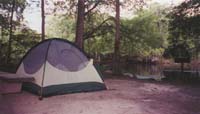 Campsite at Ginnie Springs
Campsite at Ginnie Springs 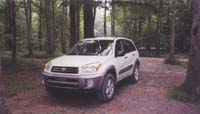 Our Toyota RAV4 Rental
Our Toyota RAV4 Rental 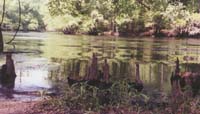 Sante Fe River
Sante Fe River 
 Source of Ginnie Springs
Source of Ginnie Springs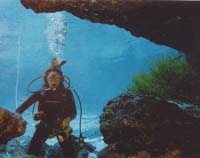 Ginnie Springs Cavern
Ginnie Springs Cavern 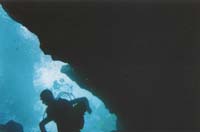 Carmen Ascending
Carmen Ascending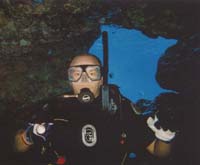 Kurt inside Ginnie Springs
Kurt inside Ginnie Springs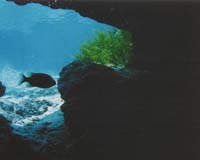 Inside Ginnie Springs Cavern
Inside Ginnie Springs Cavern Bubbles Permeating the Ceiling
Bubbles Permeating the Ceiling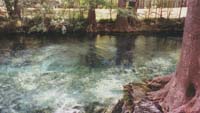 Devils Eye Spring
Devils Eye Spring 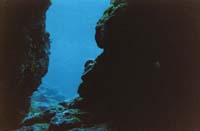 Inside Devils Ear
Inside Devils Ear  Finished Diving
Finished Diving 












